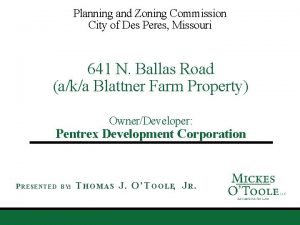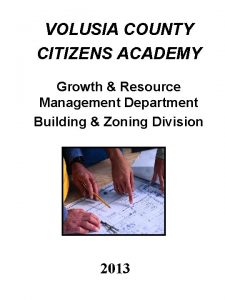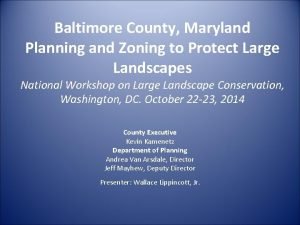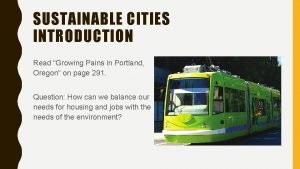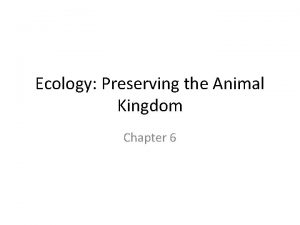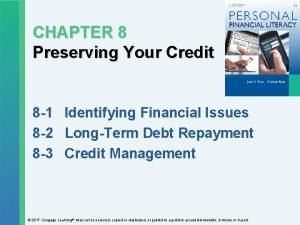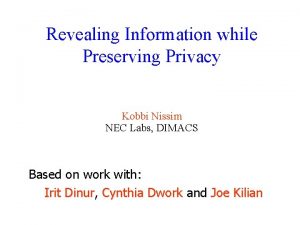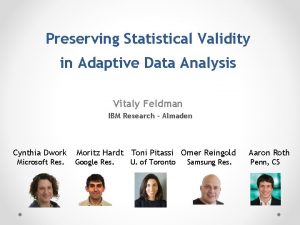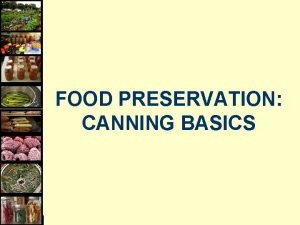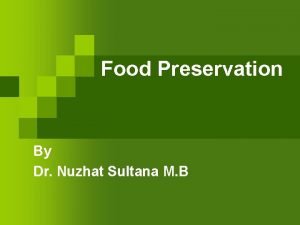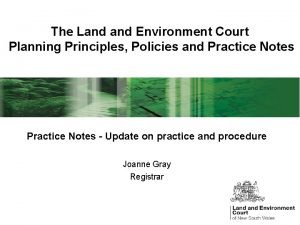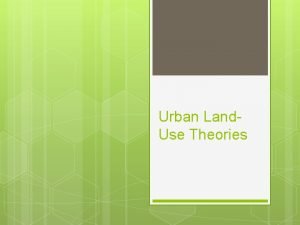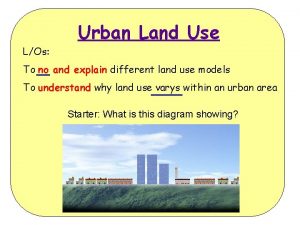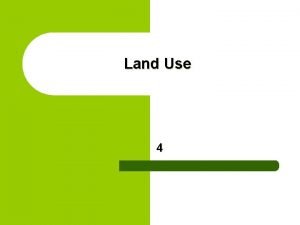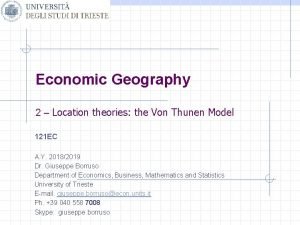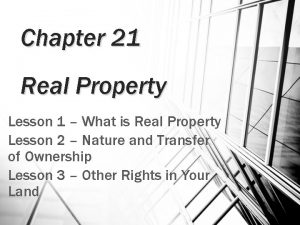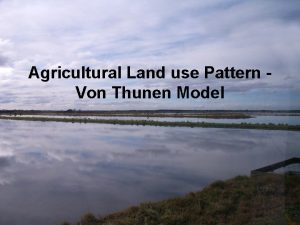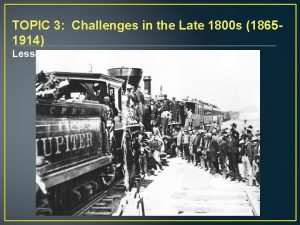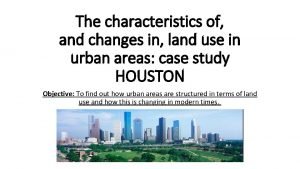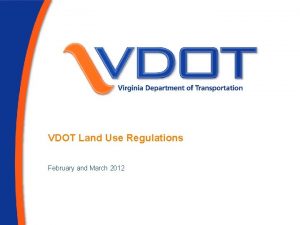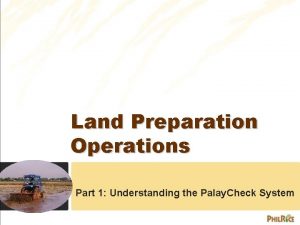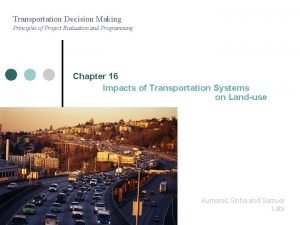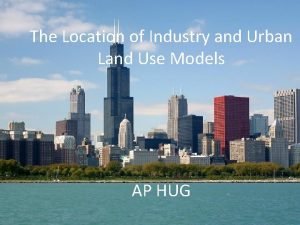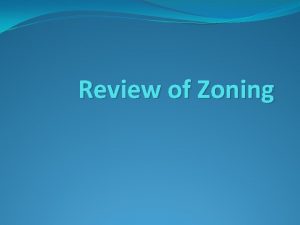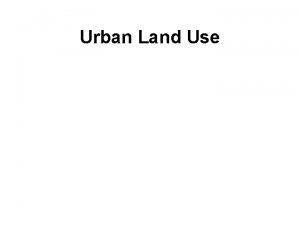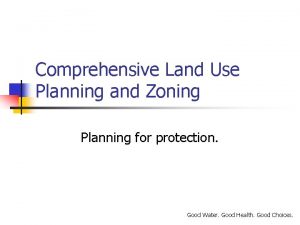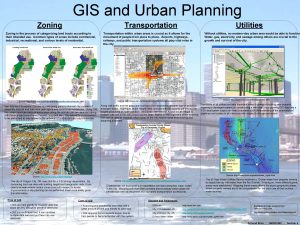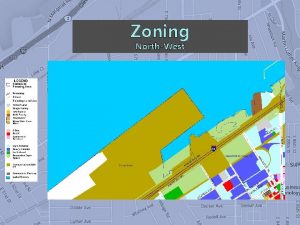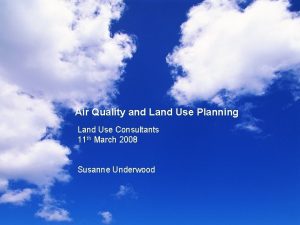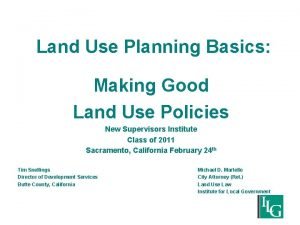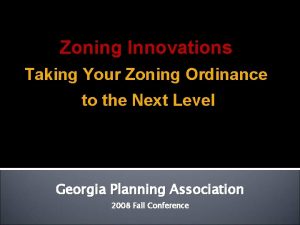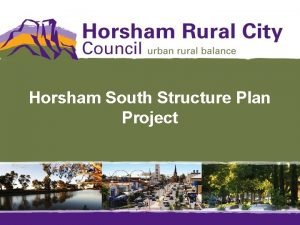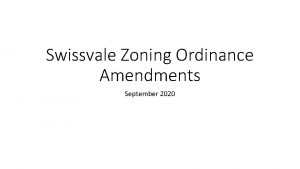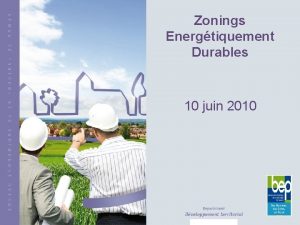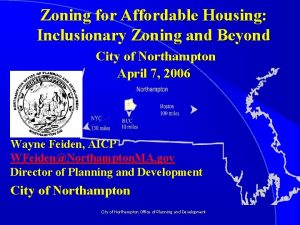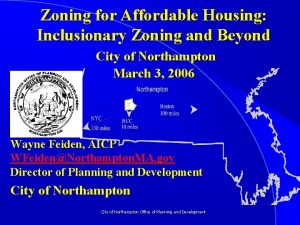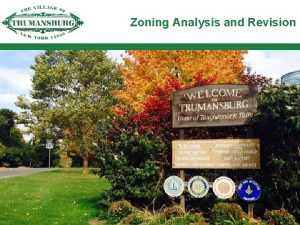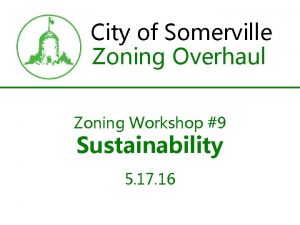Planning Zoning Land Use Preserving the Character of








































- Slides: 40

Planning Zoning & Land Use Preserving the Character of the Community Food & Water Watch www. foodandwaterwatch. org 1

Presented by Food & Water Watch www. foodandwaterwatch. org 2

A Town Without a Plan

WHAT IS A COMPREHENSIVE PLAN? A document that considers demographic information, build-out potential, land use and other planning foundations in order to guide growth and future development for a municipality. A tool designed for long-range guidance. Incorporating both general planning concepts and detailed, communityspecific planning strategies, the Plan provides both a framework to steer future policy and decisions related to land use. Food & Water Watch www. foodandwaterwatch. org 4

Comprehensive Plan & Zoning Ordinances A comprehensive plan differs from a zoning ordinance in that it is adopted as a resolution rather than as an ordinance or law. The comprehensive plan serves as a guide, whereas, the zoning ordinance is a legal instrument that is used to implement regulations and provisions that are consistent with the principles of the adopted comprehensive plan. Food & Water Watch www. foodandwaterwatch. org 5

Comprehensive Planning Two legislative tools that a community can use to implement the planning concepts of its Comprehensive Plan are its Zoning Ordinance and Subdivision and Land Development Ordinance. These documents can be used to dictate future land use, density, design standards, connectivity, etc. These documents, by law, need to be consistent with the planning goals and objectives of the Comprehensive Plan making these documents clear reflections of each other is necessary. Food & Water Watch www. foodandwaterwatch. org 6

Huntley & Huntley v. Borough Council of Oakmont 2009 Supreme Court Decision “There is some overlap between these goals and the purposes set forth in the Oil and Gas Act, most particularly in the area of protecting public health and safety. As we read the ordinance, however, the most salient objectives underlying restrictions on oil and gas drilling in residential districts appear to be those pertaining to preserving the character of residential neighborhoods. ” Opinion of the Pennsylvania Supreme Court Huntley & Huntley, Inc. v. Borough Council of the Borough of Oakmont, 964 A. 2 d 855 (Pa. 2009) Food & Water Watch www. foodandwaterwatch. org 7

Huntley & Huntley v. Borough Council of Oakmont 2009 Supreme Court Decision In Huntley v. Oakmont, the Court ruled that: The PA Oil & Gas Act tells you how to drill. The Municipal Planning Code tells you where to drill. Zoning is exclusively handled at the local level. Food & Water Watch www. foodandwaterwatch. org 8

2013 Opinion in Robinson Twp. v Commonwealth of Pennsylvania “This Court has held that a political subdivision has a substantial, direct, and immediate interest in protecting the environment and the quality of life within its borders, …the political subdivision [has] standing in a legal action to enforce environmental standards. Political subdivisions. . . The protection of environmental and esthetic interests is an essential aspect of Pennsylvanians’ quality of life and a key part of local government’s role. Local government. . has a substantial and direct interest in the outcome of litigation premised upon changes, or serious and imminent risk of changes, which would alter the physical nature of the political subdivision and of various components of the environment. [T]he same interest in the environment and in the citizenry’s quality of life cannot be characterized as remote: [W]e need not wait until an ecological emergency arises in order to find that the interest of the municipality and county faced with such disaster is immediate. ”

The Constitutional Standard PA Constitution, Article 1, Section 27 The people have a right to clean air, pure water, and to the preservation of the natural, scenic, historic and esthetic values of the environment. Pennsylvania’s public natural resources are the common property of all the people, including generations yet to come. As trustee of these resources, the Commonwealth shall conserve and maintain them for the benefit of all the people. Food & Water Watch www. foodandwaterwatch. org 10

New Rules – New Responsibilities Robinson Twp. V. Pennsylvania (2013) “This Court has held that a political subdivision has a substantial, direct, and immediate interest in protecting the environment and the quality of life within its borders, which interest confers upon the political subdivision standing in a legal action to enforce environmental standards. ” Food & Water Watch www. foodandwaterwatch. org 11

Individuals’ Use of Property v. Police Power of the Sovereign Food & Water Watch www. foodandwaterwatch. org 12

The Right to Own and Use Property Article 1, Section 1 of the Pennsylvania Constitution guarantees individuals the right to acquire, posses and to protect property: “All men are born equally free and independent, and have certain inherent and indefeasible rights, among which are those of enjoying and defending life and liberty, of acquiring, possessing and protecting property and reputation, and of pursuing their own happiness. ” Pennsylvania Constitution, Article 1, Section 1 Food & Water Watch www. foodandwaterwatch. org 13

Limitations on Right to Use Property: the Police Power of the Sovereign Individuals’ rights to use their property as they see fit is not absolute. Individuals’ constitutional freedom to use of property is restricted by the “police power” of the sovereign. The basis of the police power is the reality that individuals live and interact in a community. Food & Water Watch www. foodandwaterwatch. org 14

What is the Police Power? The basis of the sovereign’s police power is to provide for the health, safety and welfare of the community. “All property is held under some conditions, among which are, that it is not to be used to another man’s injury, and that the legislature may impose restrictions for the public good. ” Commonwealth v. Alger, 61 Mass. 53 (Mass. 1851) (emphasis added). “Probably the most important function of government is the exercise of the police power for the purpose of preserving the public health, safety and morals, and it is true that, to accomplish that purpose, the legislature may limit the enjoyment of personal liberty and property. ” Gambone v. Commonwealth, 101 A. 2 d 634, 636 (Pa. 1954). Food & Water Watch www. foodandwaterwatch. org 15

Zoning and the Police Power of the Sovereign Food & Water Watch www. foodandwaterwatch. org 16

How Zoning Works “Like Uses in Like Places” • “A typical zoning ordinance divides the municipality into districts in each of which uniform regulations are provided for the uses of buildings and land, the height of buildings, and the area or bulk of buildings and open spaces. . . Zoning Ordinances segregate industrial districts from residential districts, and there is segregation of the noises and odors necessarily incident to the operation of industry from those sections in which the homes are located. ” Robinson Twp. V. Commonwealth, 52 A. 3 d 463, 482 (Pa. Commw. Ct. 2012). Food & Water Watch www. foodandwaterwatch. org 17

The Municipal Planning Code Pennsylvania Municipalities Planning Code, Act of 1968, P. L. 805, No. 247 as reenacted and amended. An Act… To empower cities of the second class A, and third class, boroughs, incorporated towns, townships of the first and second classes including those within a county of the second class and counties of the second class through eighth classes, individually or jointly, to plan their development and to govern the same by zoning, subdivision and land development ordinances, planned residential development and other ordinances, by official maps, by the reservation of certain land for future public purpose and by the acquisition of such land; Food & Water Watch www. foodandwaterwatch. org 18

The Municipal Planning Code Pennsylvania Municipalities Planning Code, Act of 1968, P. L. 805, No. 247 as reenacted and amended. To promote the conservation of energy through the use of planning practices and to promote the effective utilization of renewable energy sources; Providing for the establishment of planning commissions, planning departments, planning committees and zoning hearing boards, authorizing them to charge fees, make inspections and hold public hearings; providing for mediation; providing for transferable development rights; providing for appropriations, appeals to courts and penalties for violations; and repealing acts and parts of acts, adding definitions; providing for intergovernmental cooperative planning and implementation agreements; Further providing for repeals; and making an editorial change, further providing for the purpose of the act; adding certain definitions; further providing for various matters relating to the comprehensive plan and for compliance by counties; providing for funding for municipal planning and for neighboring municipalities; Food & Water Watch www. foodandwaterwatch. org 19

The Municipal Planning Code Further providing certain ordinances; adding provisions relating to projects of regional impact, providing for traditional neighborhood development; further providing for grant of power, for contents of subdivision and land development ordinance, … for zoning ordinance amendment, for procedure for landowner curative amendments, for certain findings, for hearings and for governing body’s functions… and further providing for ordinance provisions, for procedure for landowner curative amendments, for hearing, and for governing body’s functions. Food & Water Watch www. foodandwaterwatch. org 20

The Municipal Planning Code Section 105. Purpose of Act. to protect and promote safety, health and morals; to accomplish coordinated development… to guide uses of land structures… to promote the conservation of energy through the use of planning practices and to promote the effective utilization of renewable energy sources; … to encourage municipalities to adopt municipal or joint municipal comprehensive plans… to ensure that municipalities adopt zoning ordinances which are generally consistent with the municipality’s comprehensive plan; to encourage the preservation of prime agricultural land natural and historic resources through easements, transfer of development rights and rezoning; to ensure that municipalities enact zoning ordinances that facilitate the present and future economic viability of existing agricultural operations to permit municipalities to minimize such problems as may presently exist or which may be foreseen to protect, preserve or conserve open land, consisting of natural resources, forests and woodlands, any actions taken to protect, preserve or conserve such land shall not be for the purposes of precluding access forestry. Food & Water Watch www. foodandwaterwatch. org 21

The Municipal Planning Code Pennsylvania Municipalities Planning Code Article VI – Zoning Section 601. General Powers. The governing body of each municipality, in accordance with the conditions and procedures set forth in this act, may enact, amend and repeal zoning ordinances to implement comprehensive plans and to accomplish any of the purposes of this act. Food & Water Watch www. foodandwaterwatch. org 22

Municipal Planning Code The provisions of all zoning ordinances may be classified so that different provisions may be applied to different classes of situations, uses and structures and to such various districts of the municipality as shall be described by a map made part of the zoning ordinance. Where zoning districts are created, all provisions shall be uniform for each class of uses or structures, within each district 53 P. S. § 10605 Food & Water Watch www. foodandwaterwatch. org 23

Oakmont, Pennsylvania Food & Water Watch www. foodandwaterwatch. org 24

Oakmont Zoning Map http: //www. oakmontborough. com/pdf_files/zoning_map. pdf Food & Water Watch www. foodandwaterwatch. org 25

ZONING CODE: Oakmont Chapter 205: Zoning, Article IV: Conditional Uses § 205 -443 Applications for gas and oil well production must be accompanied by a site plan drawn by an architect, engineer or landscape architect showing the ingress and egress of all residential properties affected by the proposed use. The site plan shall reflect landscaping adequately so as to screen and buffer neighboring properties, and the availability of ingress and egress does not disturb residential dwellings. Gas and oil well production must be located a sufficient distance from inhabited structures so as to not disturb neighboring properties and in no event shall be located within 200 feet of any inhabited structure. Gas and oil production in R-1 Residential, R-2 Residential and R-3 Residential Districts shall be limited exclusively to public parks. Food & Water Watch www. foodandwaterwatch. org 26

ZONING CODE: Oakmont The zoning code also permits drilling, as a conditional use, in the commercial and industrial districts. The current zoning code doesn’t permit car washes in the commercial district. Drilling, an industrial use, is incompatible with both residential and commercial zone uses. Food & Water Watch www. foodandwaterwatch. org 27

Why does zoning work? Zoning regulations are appropriate uses of the police power because they are restrictions on conduct that are designed to benefit the health, safety and welfare of the general community. Under a zoning regime, individuals consent to give up certain property rights in exchange for the security that their neighbors will not use property in a detrimental manner. “. . . [A] zoning ordinance implements a comprehensive zoning scheme; each piece of property pays, in the form of reasonable regulation of its use, for the protection that the plan gives to all property lying within the boundaries of the plan. ” Robinson Twp. V. Commonwealth, 52 A. 3 d 463, 482 (Pa. Commw. Ct. 2012) (emphasis added). Food & Water Watch www. foodandwaterwatch. org 28

Zoning Cannot be Arbitrary: Importance of the character of each community Because the exercise of the police power limits constitutional rights, the police power may not be used in a manner that is arbitrary. Village of Euclid, Ohio v. Ambler Realty, Co. , 272 U. S. 365, 395 -96 (1926). “A regulatory zoning ordinance, which would be clearly valid as applied to the great cities, might be clearly invalid as applied to rural communities. ” Village of Euclid, Ohio v. Ambler Realty, Co. , 272 U. S. 365 (1926). “The very essence of [z]oning is the designation of certain areas for different use purposes. ” Swade v. Zoning Hearing Board of Adjustment of Springfield Township, 140 A. 2 d 597, 598 (Pa. 1958). Food & Water Watch www. foodandwaterwatch. org 29

Unconstitutional Zoning: Act 13 In Section 3304 of Act 13, the General Assembly attempted to zone for oil and gas development across the entire state: 3304(a) General rule. -- In addition to the restrictions contained in sections 3302 (relating to oil and gas operations regulated pursuant to Chapter 32) and 3303 (relating to oil and gas operations regulated by environmental acts), all local ordinances regulating oil and gas operations shall allow for the reasonable development of oil and gas resources. Food & Water Watch www. foodandwaterwatch. org 30

Oil & Gas Drilling is an Industrial Use of the Land “. . . Act 13 permits industrial oil and gas operations as a use "of right" in every zoning district throughout the Commonwealth, including in residential, commercial, and agricultural districts. Insofar as Section 3304 permits the fracking operations and exploitation of the Marcellus Shale at issue here, the provision compels exposure of otherwise protected areas to environmental and habitability costs associated with this particular industrial use: air, water, and soil pollution; persistent noise, lighting, and heavy vehicle traffic; and the building of facilities incongruous with the surrounding landscape. Robinson Twp. v. Commonwealth, 83 A 3 d 901, 979 (Pa. 2013) , Food & Water Watch www. foodandwaterwatch. org 31

Exclusionary Zoning • Exclusionary zoning is the utilization of zoning ordinances to exclude certain uses, whether entirely or in part. Exclusionary zoning challenges typically result from the exclusion of specific types of housing, but can also include the exclusion of non-residential uses as well. Two types of exclusions exist. • De jure or total exclusion is where a zoning ordinance prohibits or fails to make provisions for a particular use. In this circumstance, a land use is not permitted by a municipality which is an example of unlawful exclusion. • De facto or partial exclusion is when an ordinance permits a specific use but fails to provide sufficient land or negates the practical development of that use. This type of exclusion typically relies upon the “fair share” doctrine. If a municipality provides too little land to accommodate a land use for which demand is forecast, the zoning ordinance could be considered exclusionary. • If a municipality permits a land use but through its regulations prohibits the practical development of that use, it could also be considered exclusionary.

Oil and Gas Development Only in Industrial Districts The Pennsylvania Supreme Court has recognized that oil and gas development is an industrial use of land. Placement of industrial oil and gas operations in zones with other industrial uses of land is in-keeping with basic tenets of zoning, which focus on placing “like” uses together This is the simplest and most straightforward option. Food & Water Watch www. foodandwaterwatch. org 33

Setbacks Requirements Scientific Justification of Setback 2016, Adequacy of Current State Setbacks for Directional High-Volume Hydraulic Fracturing in the Marcellus, Barnett, and Niobrara Shale Plays, published by the National Institute of Environmental Health Sciences, at the United States National Institute of Health. • See: https: //ehp. niehs. nih. gov/15 -10547/

Setbacks Requirements The study notes: “In Pennsylvania, setback distances are determined by the state legislature and enforced primarily by the Pennsylvania Department of Environmental Protection (PA DEP) (PA DEP 2014 b). According to Title 58, Section 3215 of the Pennsylvania Legislature, the current setback distance to buildings is 500 feet. ” (page 11) “Our paper attempts to address whether the current setback laws in three heavily drilled states within the Barnett, Marcellus, and Niobrara shale plays are sufficient to protect public health and safety. ” The majority of setback distances in the areas we studied are not derived from peer-reviewed data, data driven analysis, or historical events (Fry 2013) – they are a compromise between governments, the regulated community, environmental and citizen interest groups, and landowners (COGCC 2013). ” In part to address the issue of setbacks, the University of Maryland School of Public Health performed an in-depth analysis of the current data, and prepared a report for the Maryland Departments of the Environment and Health and Mental Hygiene. The authors recommended a minimum setback distance of 2, 000 feet from well pads (University of Maryland School of Public Health 2014). (Page 20)

Scientific Basis for Determining Setbacks A setback should not be an arbitrary distance determined by a coin toss or to be bargained over among interested parties. Setbacks need to be “derived from peer-reviewed data, data driven analysis, or historical events. ” Setbacks, in this case, have a clear purpose: to mitigate any potential harms to the health, welfare and safety of citizens and to protect the environment.

Setbacks Requirements This matter takes on even greater importance due to local government’s constitutional duty to uphold citizen’s rights as enumerated in the PA Constitution at Article I, Section 27. The borough, if legally challenged to justify a setback, should have the evidence to support a setback distance in a court of law.

University of Maryland: Potential Public Health Impacts of Natural Gas Development and Production in the Marcellus Shale in Western Maryland, July, 2014 Concludes that, based upon a variety of risk factors, a minimum setback for a HVHF well pad should be at least 2, 000 feet. The researchers took into account various scenarios involving risk factors such as fires, explosions, air quality and other conditions. http: //www. marcellushealth. org/uploads/2/4/0/8/24086586/final_report_08. 15. 2014. pdf It is clear that a PA state legislature’s determination of a 500 -foot setback is not supported by science and is inadequate to protect people and property to from known hazards associated with HVHF operations. In the course of our research, we could find no scientific evidence in support of a 500’ setback.

Low Birth Weight Study - December 13, 2017 The matter of setback takes on even more importance with the findings of a University of Chicago and Princeton study, published on December 13, 2017, in the journal, Science Advances. This study found that infants born to mothers who live close to natural gas fracking sites have a higher risk of low birth weight according to the new peer-reviewed study. http: //advances. sciencemag. org/content/3/12/e 1603021

THANK YOU FOR COMING! We at Food & Water Watch and Marcellus Outreach Butler thank you for coming today. Marcellus Outreach Butler on Facebook https: //www. facebook. com/Marcellus. Outreach. Butler More Info: Text “Local” to 69866 Contact Douglas Shields dshields@fwwatch. org Food & Water Watch www. foodandwaterwatch. org 40
 St mary's county land use and growth management
St mary's county land use and growth management Land use planning lecture notes
Land use planning lecture notes Land use planning '' lecture notes
Land use planning '' lecture notes Land use planning '' lecture notes
Land use planning '' lecture notes Define land use planning
Define land use planning Pentrex homes
Pentrex homes Volusia county growth and resource management
Volusia county growth and resource management New canaan zoning regulations
New canaan zoning regulations Baltimore county zoning map
Baltimore county zoning map Wakulla planning and zoning
Wakulla planning and zoning Briefly describe how city planners use zoning
Briefly describe how city planners use zoning Ecology preserving the animal kingdom
Ecology preserving the animal kingdom Chapter 8 preserving your credit
Chapter 8 preserving your credit Chapter 8 preserving your credit
Chapter 8 preserving your credit Revealing information while preserving privacy
Revealing information while preserving privacy Orthogonal matrix example
Orthogonal matrix example Preserving statistical validity in adaptive data analysis
Preserving statistical validity in adaptive data analysis Belen masia
Belen masia Preserving food
Preserving food Dr nuzhat sultana
Dr nuzhat sultana What are landforms
What are landforms High rocky land usually with steep sides
High rocky land usually with steep sides Land and environment court planning principles
Land and environment court planning principles Cetacean
Cetacean Burgess model of land use
Burgess model of land use L
L Hmda land use certificate download
Hmda land use certificate download Usgs land use classification
Usgs land use classification Types of land use
Types of land use Mixed land use ap human geography definition
Mixed land use ap human geography definition Alonso model of land use
Alonso model of land use Irrevocable rights to some limited use of another's land
Irrevocable rights to some limited use of another's land Von thunen's agricultural land use model
Von thunen's agricultural land use model What contribution did mexicans make to cattle ranching
What contribution did mexicans make to cattle ranching Characteristics of land use in urban areas
Characteristics of land use in urban areas Flood hazard area land use management guidelines
Flood hazard area land use management guidelines Assumptions of the von thunen model
Assumptions of the von thunen model Vdot entrance permit
Vdot entrance permit Wetland tillage
Wetland tillage Transportation
Transportation Harris ullman multiple nuclei model
Harris ullman multiple nuclei model





